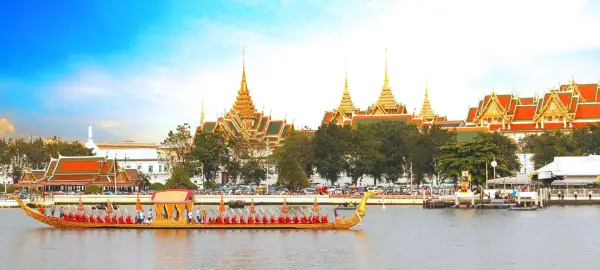Small Group Experiential Travel
Tour Code
SE10 When To Go
Jan, Nov Start
Bangkok (BKK) End
Hanoi (HAN) Countries Visited (3)
Cambodia, Thai...More > Overnight In (9)
Phnom Penh, Si...More > Activity Level
2 - Moderate? Tour Type
Cultural? - Overview
- Info & Inclusions
- Itinerary
- Map & Hotels
- Photos
- Dates & Prices
Highlights
- Max Group Size 18
- Venture in Northern Vietnam
- Magical cruise on the untouched part of Lan Ha Bay
- Majestic Angkor Temples, culturally rich Northern Thailand
- Singles friendly (view options for single travellers)
Description
Embark on a 20-day journey through the cultural, historical, and natural wonders of Thailand, Cambodia, and Vietnam. Explore the ancient temples and bustling markets of Chiang Mai and Chiang Rai in northern Thailand, before discovering the majestic Angkor Wat complex in Cambodia's Siem Reap. In Phnom Penh, uncover the city's colonial past and tumultuous history. In Vietnam, marvel at the stunning natural beauty of Ha Long Bay and Ninh Binh, and wander the charming streets of Hoi An's ancient town. Throughout the journey, indulge in the region's renowned cuisine, from spicy street food to fragrant curries and fresh seafood. This immersive tour combines cultural exploration, historical insight, and breathtaking natural scenery, offering a truly unforgettable experience in Southeast Asia.
Price Includes
- Full-time Tour Leader services and local guide support at several locations.
- Breakfast and dinner daily, some lunches as per the tour itinerary (local restaurants and some hotels).
- All transport (including local flights), accommodation, sightseeing and entrance fees for sites noted as 'visited' in the detailed itinerary.
- Gratuities for drivers, restaurant staff, porters, local guides.
- Airport transfers for travellers who are arriving/departing on tour dates and book their air through us
- Any early arriving/late departing travellers who book both their air and extra nights through us.
Exclusions
- International airfare to/from the tour.
- Tour Leader gratuities, some lunches, drinks, personal items (phone, laundry, etc), domestic and international (if applicable) air taxes, visa fees, and any excursions referenced as 'optional'.
- Airport transfers for Land Only customers.
- Optional trip cancellation insurance - for info click on the "Resources" tab
Trip Info
- Seasonality and Weather:
Our departures are set to coincide with the coolest and driest time of year, November to April.
In November, the northern regions typically transition to the dry season with less rain and milder temperatures. The central regions will likely see the end of the rainy season with decreasing rainfall and continued warmth. The southern regions and coasts might still have some rain early in the month as the monsoon recedes, but conditions generally improve to warmer and drier. November is often a shoulder season with improving weather, offering a mixed experience before the peak tourist season.
In January, travellers to the northern regions of Thailand, Vietnam, and Cambodia can expect generally dry and pleasant conditions with comfortable daytime temperatures and cooler evenings. The central regions will likely be warm and dry, while the southern regions and coasts should be warm and sunny, ideal for beaches. Overall, January offers a very pleasant travel experience due to the drier and milder weather across much of the area.
Overall you should prepare for warm, sticky weather with the possibility of rain and some chilly nights/mornings in a few locales. - Transport and Travel Conditions:
Land transport throughout will be by private air-conditioned bus. Most of the driving days are not long, but progress can be slow due to the nature of the roads and traffic. This highlight packed program benefits greatly from the availability of convenient short-haul internal flights that tie this trip together.
Porters are available at hotels but you must be able to manage with your baggage at airports and some smaller hotels.
The tour is not strenuous though it is busy; you must be steady on your feet and be able to endure some heat and some long days. We have numerous walking tours and visit several sites that are LARGE with steps and uneven surfaces. Our level "2" rating for this tour refers to the ambitious itinerary, full travel days, early starts, walking tours, uneven surfaces, and the possibility of heat in some locales
Am I suitable for this tour? Please refer to our self-assessment form - Activity Level: 2
These are particularly busy tours that feature a lot of moving around, sometimes by train and short journeys on local transport. Walking tours of towns and cities are leisurely but you should be prepared to be on your feet for several hours. Some of our cultural trips that occur at high altitude and/or require greater independence with baggage handling (at hotels, airports, train stations) also fall into this category.
To learn more about the Activity levels, please visit our tour styles page. - Accommodation:
Hotels used on tour are modern, comfortable, well-located, air-conditioned, mostly 4, some 3-star properties with en suite bath/toilet. Some are resort-style boutique properties with plenty of charm and atmosphere. Single rooms are limited and possibly smaller than twins.
Most hotel rooms are well-equipped and likely include hairdryers and irons, minibar fridge, TV. Most hotels provide complimentary purified drinking water. Some hotels have swimming pools. Our cruise can be considered "luxury" accommodation.
Click on "Map & Hotels" tab elsewhere on this page for more info, including details about our cruise vessels. - Staff and Support:
Tour Leader throughout, local drivers, local guides at various locations. - Group Size:
Maximum 18 (plus Tour Leader)
View / Print Itinerary
- Day 1:Arrival in BangkokArrival in Bangkok, Thailand's capital and largest city. Founded in 1782 by King Rama I, Bangkok (or Krung Thep, "City of Angels," in Thai) sits on the Chao Phraya River about 25 kilometres (15 miles) from the Gulf of Thailand. The city blends traditional culture with contemporary urban life — ornate Buddhist temples stand alongside modern skyscrapers, while street markets operate in the shadow of air-conditioned shopping centres.
Bangkok serves as Thailand's political, economic, and cultural heart, home to approximately 10 million people in the greater metropolitan area. The city's architecture reflects its history, with royal palaces and temples dating from the late 18th century coexisting with colonial-era buildings and contemporary development.
This evening we meet our Tour Leader and fellow travellers for a welcome dinner.
Overnight in Bangkok.
Included Meal(s): Dinner, if required - Day 2:Bangkok: City ExplorationOur Bangkok exploration begins at the Grand Palace, situated on the Chao Phraya River. Construction started in 1782 under King Rama I, and the complex covers over 1.5 square kilometres (0.9 square miles). The palace served as the official residence of Thai kings until 1925, though it remains the ceremonial and spiritual centre of the Thai kingdom.
Within the palace grounds sits Wat Phra Kaeo, home to the Emerald Buddha, Thailand's most sacred Buddhist image. Despite its name, the 75-centimetre (30-inch) statue is carved from green jade rather than emerald. The image's history spans centuries and countries — since its discovery in the 15th century, it has resided in Lampang, Chiang Rai, and two locations in Laos (Luang Prabang and Vientiane) before King Rama I brought it to Bangkok in 1784.
This afternoon we visit Wat Pho, also known as the Temple of the Reclining Buddha. Founded in the 16th century and extensively renovated in the 1780s, Wat Pho ranks as Bangkok's largest and oldest temple. The main attraction is the 46-metre (150-foot) long, 15-metre (49-foot) high gold-plated reclining Buddha, whose feet display intricate mother-of-pearl inlay work depicting the 108 auspicious characteristics of the Buddha. The temple grounds also contain over 1,000 bronze Buddha images rescued from Ayutthaya and Sukhothai by Rama I's brother after those cities fell into ruin.
We cross the Chao Phraya River by boat to visit Wat Arun, the Temple of the Dawn. Built in the early 19th century during King Rama II's reign, the temple's central prang (tower) rises 81 metres (265 feet), making it Bangkok's tallest temple structure. The tower is covered with fragments of Chinese porcelain, creating a shimmering effect best appreciated from a distance. The temple takes its name from Aruna, the Hindu god of dawn. Four satellite prangs contain statues of the Buddha at important life stages: at birth (north), in meditation (east), preaching his first sermon (south), and entering Nirvana (west).
Overnight in Bangkok.
Included Meal(s): Breakfast and Dinner - Day 3:Bangkok - Fly to Chiang RaiToday we fly to Chiang Rai, capital of Thailand's northernmost province. Founded in 1262 by King Mengrai, Chiang Rai served as the first capital of the Lanna Kingdom before that honour passed to Chiang Mai. The city's location near the borders of Myanmar and Laos has given it historical importance as a crossroads of cultures and trade routes.
The surrounding region is home to several ethnic minority groups, including Karen, Hmong, Akha, Lisu, and Lahu peoples, whose villages dot the mountains. The landscape differs markedly from central Thailand — mountains covered in forest, tea plantations on hillsides, and the Mekong River forming the border with Laos to the north.
Evidence of the city's historic importance can be seen in monuments such as Wat Phra Kaeo, where the Emerald Buddha was discovered in 1434 when lightning struck the temple's chedi, revealing the jade statue hidden within plaster. The temple's current replica, presented in 1991, allows visitors to appreciate the significance of the original, now housed in Bangkok.
Depending on our flight time, we may begin our sightseeing programme upon arrival.
Overnight in Chiang Rai.
Included Meal(s): Breakfast and Dinner - Day 4:Chiang Rai TouringWe begin at Wat Phra Kaeo, Chiang Rai's most revered temple. According to legend, lightning struck and cracked the chedi in 1436, revealing a plaster-covered statue that contained the Emerald Buddha. The jade image remained here until King Tilokarat of Chiang Mai attempted to bring it to his capital in 1468 — legend says the elephants carrying the Buddha repeatedly walked toward Lampang instead, which the king interpreted as a divine sign, so the statue remained there for the next three decades.
The temple dates from the 13th century and features a fine bot (ordination hall) decorated with elaborate woodcarving. The Phra Chao Lang Thong, one of the largest surviving bronze statues from the early Lanna period, stands as testament to the artistic achievements of the era. A replica of the Emerald Buddha, presented in 1991, now occupies the place of honour.
This afternoon we take a boat trip on the Maekok River to visit a hill tribe village. The mountains of northern Thailand are home to several ethnic minority groups whose ancestors migrated from southern China and Tibet. The Karen, Hmong (also called Meo), Mien, Lahu, Akha, and Lisu peoples maintain distinct languages, traditional dress, and cultural practices. These groups originally followed migration routes through these mountains, with some communities settling in Thailand relatively recently — many Hmong villages, for example, date from the mid-20th century.
Each group has adapted to life in the mountains through different means: the Karen practice rotational agriculture and are known for their weaving; the Hmong cultivate highland rice and are skilled metalworkers; the Akha, who arrived more recently from Myanmar, maintain animist beliefs and distinctive ceremonial gates at village entrances. Our visit provides insight into daily life in these communities, though it's important to remember that increasing tourism and integration with Thai society are gradually changing traditional ways of life.
We also visit the Hill Tribe Education Centre, where displays show traditional clothing, implements, and cultural artifacts from each ethnic group, providing context for understanding the region's cultural diversity.
Overnight in Chiang Rai.
Included Meal(s): Breakfast and Dinner - Day 5:Chiang Rai - Chiang MaiToday we travel by road to Chiang Mai, Thailand's second-largest city and the cultural capital of the north. Founded in 1296 by King Mengrai as the capital of the Lanna Kingdom, Chiang Mai served as an independent city-state until it came under Siamese control in the late 18th century. The city sits in a valley at 310 metres (1,020 feet) elevation, surrounded by mountains that reach over 2,000 metres (6,560 feet).
After settling into our hotel, we participate in a Thai cooking class, learning to prepare authentic northern Thai cuisine. Northern Thai food differs from the cuisine of Bangkok and central Thailand — it shows influences from Myanmar and Yunnan, with dishes often featuring pork, sticky rice, and fermented ingredients rather than the coconut-based curries common in the south.
Our class begins at a local market, where we learn to identify Thai ingredients: varieties of basil, lemongrass, galangal (similar to ginger), Thai aubergines, and the essential fish sauce and shrimp paste. We then prepare several dishes under guidance from our instructor, learning techniques for creating curry pastes, balancing the fundamental Thai flavours (sweet, sour, salty, and spicy), and achieving the proper textures. Dishes typically include a curry, a stir-fry, and a soup. At the end of the lesson, we enjoy the meal we've prepared.
Overnight in Chiang Mai.
Included Meal(s): Breakfast and Dinner - Day 6:Chiang Mai Area TouringToday we explore Chiang Mai and its surroundings. The city contains over 300 Buddhist temples, many built during the Lanna Kingdom period (13th-18th centuries) in a distinctive architectural style that differs from central Thai temple design. Lanna temples typically feature multi-tiered roofs with elaborate carved wooden decorations, and often display Burmese artistic influences reflecting historical connections between the two regions.
We focus on the old quarter within the ancient moat, where traditional wooden houses and temples cluster along narrow lanes. At Wat Phra Singh, one of Chiang Mai's most important temples, we visit the main chedi (stupa) built in 1345 to house the ashes of King Kam Fu. The Viharn Lai Kam, a masterpiece of Lanna architecture, contains one of Thailand's three sacred Phra Singh Buddha images. The viharn's interior walls display vibrant murals depicting daily life during the late 19th century — merchants conducting business, children playing, farmers working in rice fields, and various social activities that provide a visual record of the period.
We also visit Chiang Mai's Arts and Cultural Centre, housed in a restored colonial-era building. The centre's exhibitions cover the city's history from its founding through the present, including displays on traditional crafts, the Lanna Kingdom's political structure, and the region's ethnic diversity.
Overnight in Chiang Mai.
Included Meal(s): Breakfast and Dinner - Day 7:Chiang Mai Area TouringThis morning we visit an orchid farm in the Mae Sa Valley, where the Mae Sa River creates a series of small waterfalls as it descends from Doi Suthep mountain. The valley's climate — warm temperatures with high humidity — proves ideal for orchid cultivation, and numerous farms grow both native species and hybrids for export and domestic sale.
We continue to an elephant conservation centre, where we learn about the changing role of elephants in Thai society. Historically, elephants served multiple functions in Southeast Asia: as vehicles for royalty, as essential workers in logging and agriculture, and as animals of war. The white elephant held particular significance — these rare individuals (not actually white, but showing specific skin discolourations) became symbols of royal power and prosperity.
Thailand's logging industry employed thousands of elephants through the mid-20th century. When the government banned commercial logging in 1989 following severe floods caused by deforestation, many elephants and their mahouts (handlers) lost their livelihoods. Some elephants were released into the wild, where they came into conflict with farmers; others were put to work in tourism, often under poor conditions.
The conservation centre we visit works to provide proper care for elephants while preserving the traditional relationship between elephants and mahouts. We observe how mahouts train and care for their animals, learn about elephant behaviour and biology, and understand the challenges facing elephant conservation in modern Thailand. The centre also participates in breeding programmes and veterinary care for working elephants throughout the region.
Overnight in Chiang Mai.
Included Meal(s): Breakfast and Dinner - Day 8:Chiang Mai, Thailand - Phnom Penh, CambodiaToday we fly to Phnom Penh, likely connecting through Bangkok. Cambodia's capital sits at the confluence of the Mekong, Tonle Sap, and Bassac rivers, a location that has made it strategically important for centuries. The city served as the Khmer royal capital from the 15th century (with interruptions), becoming the permanent capital in 1866.
French colonists, who controlled Cambodia from 1863 to 1953, transformed Phnom Penh with tree-lined boulevards, colonial mansions, and administrative buildings designed to evoke Parisian elegance. The city earned the nickname "Pearl of Asia" for its architecture and atmosphere. However, the Khmer Rouge forcibly evacuated the entire urban population in 1975, and when Vietnamese forces drove them out in 1979, they found an abandoned city. Phnom Penh has recovered, though many colonial buildings remain in deteriorating condition.
The city's name comes from Wat Phnom ("Temple on a Hill"), a Buddhist temple built on an artificial mound. Legend holds that in 1372, a wealthy woman named Penh found several Buddha statues washed ashore and had the hill built to house them.
Flight times permitting, we may begin our sightseeing programme upon arrival.
Overnight in Phnom Penh.
Included Meal(s): Breakfast and Dinner - Day 9:Phnom Penh: Tuol Sleng Prison & City TourToday we confront Cambodia's traumatic recent history, beginning at Tuol Sleng Genocide Museum. This former high school was converted by the Khmer Rouge into Security Prison 21 (S-21), the regime's largest torture and interrogation centre. Between 1975 and 1979, approximately 20,000 people passed through Tuol Sleng — political prisoners, intellectuals, suspected dissidents, ethnic Vietnamese and Chinese, and eventually Khmer Rouge members accused of treachery. Prisoners were photographed upon arrival, interrogated under torture to produce false confessions, and then transported to execution sites. Only seven prisoners survived.
The buildings remain largely as they were found in January 1979. Classrooms became tiny cells or torture chambers, their transformation documented by thousands of black and white photographs that line the walls — prisoners' faces showing fear, defiance, or resignation. The museum serves as both memorial and historical record.
We continue to Choeung Ek, one of nearly 400 "Killing Fields" where the Khmer Rouge executed prisoners. Located 17 kilometres (11 miles) from the city, Choeung Ek served as the primary execution ground for Tuol Sleng prisoners. Approximately 17,000 people were killed here. A tall stupa now houses over 5,000 skulls exhumed from mass graves.
Returning to Phnom Penh, we visit the National Museum, which houses one of the world's largest collections of Khmer art. The collection includes over 14,000 objects spanning prehistoric times through the Angkorian period and beyond. Stone sculptures from Angkor and pre-Angkorian sites form the centrepiece — standing Buddhas, dancing apsaras, lingams, and architectural elements demonstrate the evolution of Khmer artistic styles over more than 1,000 years. The museum building, constructed between 1917 and 1924, takes design inspiration from Khmer temple architecture.
We walk to the Royal Palace, the official residence of Cambodia's king since the 1860s. We visit the Throne Hall and Silver Pagoda. The Silver Pagoda, named for its floor of 5,000 silver tiles, houses Cambodia's most sacred Buddha images, including an emerald Buddha and a life-sized gold Buddha encrusted with diamonds.
We conclude at Wat Phnom, the temple that gives the city its name. Built in 1372 and rebuilt several times since, the temple sits atop a 27-metre (89-foot) artificial hill and remains an active place of worship.
Overnight in Phnom Penh.
Included Meal(s): Breakfast and Dinner - Day 10:Phnom Penh - Fly to Siem ReapToday we fly to Siem Reap, gateway to the temples of Angkor. The town remained little more than a village when French explorers arrived in the 19th century. Henri Mouhot's widely publicized accounts of Angkor, published in 1860, drew Western attention to the ruins, though local Khmer and Buddhist monks never abandoned the site. Siem Reap has since grown into a tourist centre serving the archaeological complex.
The temples of Angkor represent the remains of the Khmer Empire, which dominated mainland Southeast Asia from the 9th to 15th centuries. At its height under King Jayavarman VII (ruled 1181-1218), the empire controlled territory from present-day Myanmar to Vietnam and from southern China to the Malay Peninsula. Angkor itself may have been the world's largest pre-industrial city, with populations estimated at over one million.
Depending on flight times, we may begin our sightseeing programme upon arrival.
NOTE: The order of Siem Reap sightseeing may vary at the discretion of your Tour Leader.
Overnight in Siem Reap.
Included Meal(s): Breakfast and Dinner - Day 11:Siem Reap: Rolous Group, Chao Srei Vibol & Angkor WatOur morning begins with a walk from central Siem Reap (tuk-tuks available for those preferring not to walk), passing local schools and villages and crossing rice fields to reach the Roluos temple group. These temples represent the Khmer civilization's earliest major constructions, dating from the late 9th century when the site served as Hariharalaya, the first capital of the Khmer Empire under King Indravarman I.
We explore three main temples, each dedicated to the Hindu god Shiva. Preah Ko (Sacred Bull), built in 880, features six brick towers on a raised platform and displays some of Angkor's finest early stone carving. Bakong, constructed in 881, represents the first Khmer temple built entirely of stone rather than brick. Its pyramid structure, rising in five tiers, established the template for later temple mountains including Angkor Wat. Lolei, built on an artificial island in a now-dry reservoir, completed the complex in 893.
This afternoon we visit Chao Srei Vibol, a small 12th-century temple atop a hill that receives few visitors. The central sanctuary remains unrestored, with trees growing from the stones and galleries open to the forest. The peaceful setting and lack of crowds make this an ideal spot for contemplating Angkor's relationship with the jungle that once reclaimed these monuments.
In the mid-afternoon we proceed to Angkor Wat, visiting during the less crowded later hours. We enter through the eastern gate (Ta Kou) rather than the more commonly used western entrance, approaching the temple from a different perspective. The temple's galleries, libraries, pavilions, courtyards, and lotus ponds create a complex designed to represent Mount Meru, the sacred mountain at the centre of the Hindu universe. The reflection pools surrounding the temple mirror its five towers, doubling the visual impact.
Overnight in Siem Reap.
Included Meal(s): Breakfast and Dinner - Day 12:Siem Reap: Angkor Archaeological ParkToday we travel to Banteay Srei, often called the jewel of Angkor. Built in AD 967, this temple stands apart from Angkor's other monuments in several ways. Unlike the massive royal projects we've been exploring, Banteay Srei was commissioned by Yajnavaraha, a Brahman priest and spiritual advisor to King Jayavarman V. The temple's name means "Citadel of Women" or "Citadel of Beauty" — a reference to the delicate artistry of its carvings.
Built on a smaller scale and constructed from fine-grained pink sandstone, Banteay Srei allowed artisans to create extraordinarily detailed relief work. The lintels, pediments, and standing figures display craftsmanship unmatched elsewhere in the Angkor complex, with scenes from Hindu epics rendered in miniature precision. The temple was one of the first restored by French archaeologists using anastylosis — carefully dismantling and rebuilding structures using original stones.
Around midday we visit Kirimanon, a village within the Angkor Archaeological Park where residents maintain traditional ways of life. We learn about the customs and culture of people living among these ancient monuments and, depending on the season, may observe rice planting, roof weaving with palm leaves, vegetable harvesting, or other agricultural activities.
Our final visit today is to Angkor Thom during the less crowded late afternoon. The fortified city, built by King Jayavarman VII in the late 12th century, served as the Khmer Empire's capital. We enter through the South Gate, where giant stone faces gaze in four directions, and proceed to Bayon Temple at the city's centre. Famous for its 54 towers bearing serene stone faces — likely representing the bodhisattva Avalokiteshvara or perhaps the king himself — Bayon creates a labyrinth of galleries and courtyards.
We also visit Baphuon temple-mountain, the Elephant Terrace (used for royal ceremonies), and the Terrace of the Leper King, both showcasing the engineering and artistic achievements of Angkor's builders. The Elephant Terrace extends over 300 metres (984 feet) and would have supported wooden pavilions where the king reviewed parades and ceremonies. The Terrace of the Leper King takes its name from a 15th-century statue found at the site, though scholars debate whether the figure represents a king or the Hindu god of death, Yama.
Overnight in Siem Reap.
Included Meal(s): Breakfast and Dinner - Day 13:Siem Reap, Cambodia - Fly to Da Nang, Vietnam - Hoi AnToday we fly to Da Nang and continue by road to Hoi An. Da Nang sits on a peninsula where the Han River flows into the South China Sea. Our route takes us past the Marble Mountains, a cluster of five limestone peaks with marble outcrops. These mountains hold religious significance for both Buddhists and followers of traditional Vietnamese beliefs, with caves housing shrines and statues. At the mountains' base, artisans craft marble objects — stone quarrying has continued for centuries, though authorities now restrict extraction to protect the site.
We continue to Hoi An, one of Vietnam's most atmospheric towns. This ancient trading port flourished from the 15th to 19th centuries as a major Southeast Asian commercial hub, attracting Japanese, Chinese, Dutch, Portuguese, and French merchants. The town centre preserves over 1,000 timber-frame buildings, their architecture reflecting diverse influences. Hoi An's designation as a UNESCO World Heritage Site in 1999 recognized it as an exceptionally well-preserved example of a Southeast Asian trading port.
The town's location on the Thu Bon River, several kilometres from the coast, protected it from coastal storms that frequently damaged other ports. However, by the late 19th century, the river's silting made it inaccessible to larger ships, and trade shifted to Da Nang. This decline ironically preserved Hoi An — without economic pressure to modernize, the old buildings survived largely intact.
Upon arrival, flight times permitting, we'll have an informal orientation tour of this compact old town.
Overnight in Hoi An.
Included Meal(s): Breakfast and Dinner - Day 14:Hoi An: Walking Tour & Boat TripToday we explore Hoi An's old town on foot, discovering architecture that blends Vietnamese, Chinese, Japanese, and French influences. The town's wealth came from trade in ceramics, silk, pepper, and cinnamon, and successful merchants built elaborate houses that still line the streets
Hoi An's Japanese Covered Bridge, dating to the 18th century, represents one of Vietnam's most iconic structures. The bridge connects what were historically the Japanese and Chinese quarters. On its northern side, a small temple serves as protection for sailors — the bridge was funded by the Japanese community but has been maintained by Chinese and Vietnamese residents over the centuries, symbolizing the town's multicultural heritage.
The Tran Family Temple has remained in the same family for 15 generations. Built in 1802 in a style combining Chinese and Japanese influences, the temple serves both as an ancestral shrine and family home. The architecture features carved wooden panels, curved tile roofs, and a layout following traditional Vietnamese feng shui principles.
We visit a Chinese Assembly Hall, built by merchants from specific Chinese provinces as meeting places and temples. Hoi An has several such halls, each serving immigrants from different regions — Fujian, Cantonese, Hainanese, and others. The halls' ornate decorations honour Chinese deities and historical figures.
At the Central Market, vendors sell fresh produce, spices, and prepared foods. The market operates daily, supplying both residents and the town's restaurants. Hoi An's culinary reputation draws visitors for dishes like cao lau (noodles unique to Hoi An made with water from a specific well), white rose dumplings, and banh mi sandwiches.
We take a boat trip on the Thu Bon River, which remains essential to the region's economy and transportation more than 500 years after merchants first navigated it. The river supports fishing, agriculture, and tourism, with traditional wooden boats now carrying visitors rather than porcelain and spices.
Overnight in Hoi An.
Included Meal(s): Breakfast and Dinner - Day 15:Hoi An: My Son Cham Dynasty ComplexThis morning we visit My Son (pronounced "mee-sohn"), a UNESCO World Heritage Site comprising over 70 architectural works from the Cham Dynasty. The Chams controlled much of central Vietnam from the 2nd to 15th centuries, establishing a Hindu kingdom influenced by Indian culture through maritime trade. My Son served as the dynasty's spiritual centre and burial ground for Cham royalty.
Construction at My Son began in the 4th century and continued for nearly 1,000 years, creating a complex of brick towers and sanctuaries dedicated primarily to Shiva. The Cham builders developed sophisticated techniques for creating bricks that bonded so tightly that researchers still debate the construction methods. Unlike the stone temples of Angkor, Cham structures used brick almost exclusively, with stone reserved for decorative elements.
The site's remote location in a mountain-ringed valley protected it for centuries after the Cham kingdom's decline. However, the Vietnam War brought devastating damage — American forces bombed My Son in 1969. Many structures were destroyed, though enough survived to demonstrate the Chams' architectural achievements. The remaining towers, carved sandstone lintels, and lingam shrines reveal clear influences from Indian Hindu temple design, adapted to local materials and aesthetics.
My Son's forested setting creates a contemplative atmosphere. The site receives far fewer visitors than Angkor, allowing time to examine details and imagine the complex during its centuries as a living religious centre.
We return to Hoi An in time for a late lunch. The remainder of the day is free to explore at leisure. The Hoi An riverside, lined with cafés, galleries, and tailor shops, bustles with activity. The town is particularly known for its tailors, who can create custom clothing in as little as 24 hours.
Overnight in Hoi An.
Included Meal(s): Breakfast and Dinner - Day 16:Hoi An - Da Nang - Fly to Hanoi - Ninh BinhToday we fly to Hanoi and continue by road to Ninh Binh Province, approximately 100 kilometres (62 miles) south of the capital. The region is often called "Halong Bay on land" for its karst limestone landscape — the same geological formations that create Halong Bay's seascape here rise from rice fields and river valleys.
After lunch we visit Hoa Lu, which served as Vietnam's capital during the Dinh Dynasty (968-980) and early Le Dynasty (980-1009). We visit temples dedicated to these dynasties' rulers, set among karst peaks that provided natural fortifications. The location's defensibility made it an ideal capital during this period of frequent conflict with Chinese forces to the north.
We continue to the Trang An eco-tourism complex and Hang Mua Cave. A climb of 450 steps brings us to a viewpoint overlooking the karst landscape, rice fields, and waterways below. The panorama reveals how geological processes over millions of years created this terrain — an ancient coral reef uplifted by tectonic forces, then eroded by water into the peaks and valleys we see today. The region gained UNESCO World Heritage designation in 2014 under the name Trang An Landscape Complex, recognized for both its natural beauty and archaeological significance.
Overnight in Tam Coc.
Included Meal(s): Breakfast, Lunch and Dinner - Day 17:Ninh Binh - La Ha Bay Overnight CruiseThis morning we journey to Lan Ha Bay, passing through the Red River Delta with its rice fields at various stages of cultivation. Lan Ha Bay, lying south and east of Cat Ba Town, comprises approximately 300 karst islands and limestone outcrops. Being farther from Halong City than the more famous Halong Bay, Lan Ha receives fewer tourist boats, creating a more secluded atmosphere.
We arrive at Dinh Vu port around midday and board our overnight boat. Lunch is served as we cruise toward Lan Ha Bay, entering a seascape of limestone karst peaks rising from emerald waters. These formations began as coral reefs millions of years ago; tectonic uplift and erosion created the landscape we see today.
During the afternoon we explore hidden lagoons and floating villages, observing how communities have adapted to life on the water. We have opportunities to swim or kayak among the limestone cliffs, paddling through channels barely wider than the kayak. The scale of the karst formations becomes particularly apparent at water level.
As evening approaches, we drop anchor in an isolated area. Under clear skies, the upper deck offers excellent stargazing away from city lights, while the bay's calm waters reflect the sunset's colours.
NOTE: Due to weather and operational conditions, the cruise's itinerary is subject to change without prior notice.
Overnight on board.
Included Meal(s): Breakfast, Lunch and Dinner - Day 18:Lan Ha Bay - HanoiThose interested may participate in a tai chi class on deck before breakfast, practicing gentle movements as the sun rises over the karst landscape.
This morning we explore a cave system featuring thousands of stalactites and stalagmites formed over millions of years by water slowly depositing calcium carbonate. The formations create columns, curtains, and fantastical shapes that appear throughout the cave chambers.
We cruise back through the karst peaks, returning to Tuan Chau Marina by late morning. Around noon we disembark and drive to Hanoi, arriving mid-afternoon.
Later this afternoon we explore Hanoi's Old Quarter, also known as the "Quarter of 36 Streets." This ancient commercial district developed between the 11th and 18th centuries, with streets organized by trade guilds — Hang Bac (Silver Street), Hang Ma (Paper Street), and so on. Many streets still specialize in particular goods. The narrow shophouses, typically just 3-5 metres (10-16 feet) wide but extending deep into the block, represent traditional Vietnamese urban architecture.
This evening we attend a water puppet show, an art form unique to Vietnam that originated in the Red River Delta. Puppeteers stand waist-deep in water behind a screen, manipulating wooden puppets that appear to move across the water's surface. The performance, accompanied by traditional instruments, depicts rural life, legends, and historical tales.
Overnight in Hanoi.
Included Meal(s): Breakfast, Lunch and Dinner - Day 19:Hanoi City TouringToday we explore Hanoi's historic highlights, witnessing a capital city where tree-lined boulevards, lakes, parks, belle époque villas, and Buddhist temples create a distinctive urban landscape.
We begin at the Ho Chi Minh Mausoleum, the final resting place of Vietnam's most iconic leader. The building, constructed from materials gathered from across Vietnam, closely follows the design of Lenin's Mausoleum in Moscow. Ho Chi Minh's preserved body lies in a glass case, and the site serves as a place of pilgrimage for Vietnamese visitors. The mausoleum periodically closes for maintenance, in which case we view it from the exterior only.
We continue to Ho Chi Minh's Stilt House behind the Presidential Palace. Despite his position as President of North Vietnam, Ho Chi Minh chose to live in this modest two-room house built in traditional style, elevated on wooden pillars. The building, constructed from polished and lacquered wood, demonstrates his commitment to simplicity — a stark contrast to the grandiose Presidential Palace nearby, which he never occupied.
The One Pillar Pagoda, originally built in 1049, represents one of Vietnam's most distinctive temples. The lotus-shaped structure rises from a square pool on a single stone pillar, rebuilt after French forces destroyed the original in 1954. The design symbolizes a lotus blossom emerging from muddy water.
At the Ethnology Museum, one of Vietnam's finest museums, we gain insight into the country's 54 ethnic minority groups. The indoor galleries display traditional clothing, tools, and cultural artifacts, while the outdoor section features full-scale reconstructions of minority housing styles.
We visit the Temple of Literature, established in 1076 as Vietnam's first national university. For nearly 700 years, this Confucian institution educated the sons of mandarins and, later, commoners who passed rigorous examinations. Stone stelae mounted on turtle pedestals record the names of successful examination candidates from 1442 to 1779.
We conclude at Hoa Lo Prison Museum, known to American prisoners of war as the "Hanoi Hilton." French colonists built this prison in the late 19th century to house Vietnamese political prisoners and revolutionaries. During the Vietnam War, North Vietnam held captured American pilots here. The museum presents both periods of the prison's history.
Overnight in Hanoi.
Included Meal(s): Breakfast and Dinner - Day 20:DepartureDeparture from Hanoi.
BON VOYAGE!
Included Meal(s): Breakfast
Regions Visited: Asia and Southeast Asia
Countries Visited: Cambodia, Thailand and Vietnam
Countries Visited: Cambodia, Thailand and Vietnam
*The red tour trail on the map does not represent the actual travel path.



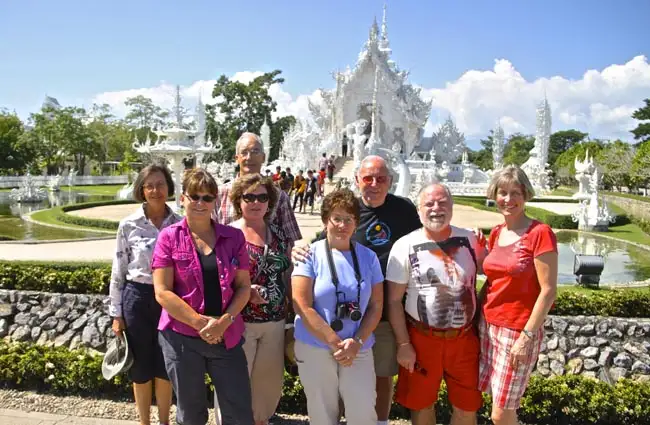
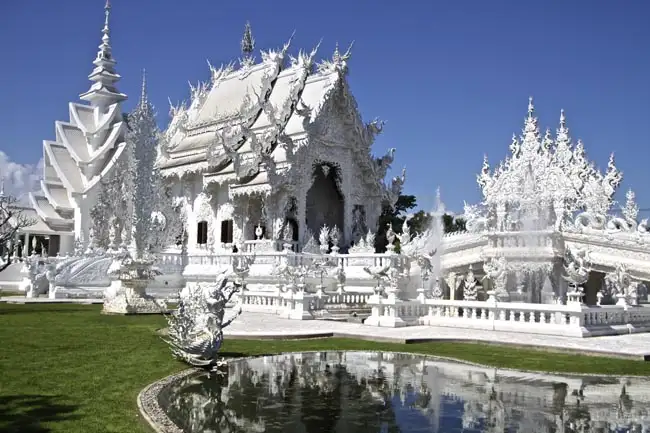

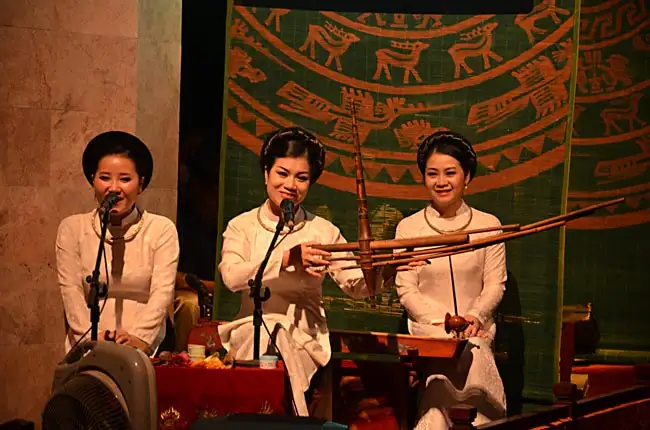

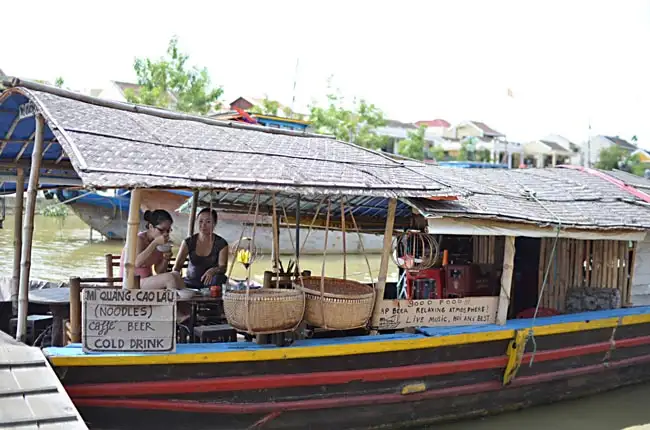

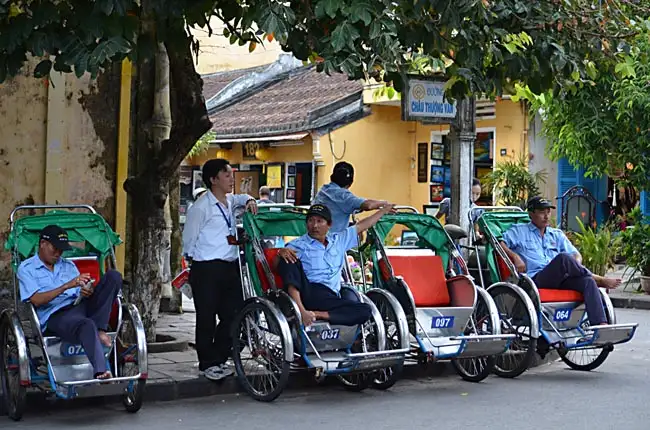

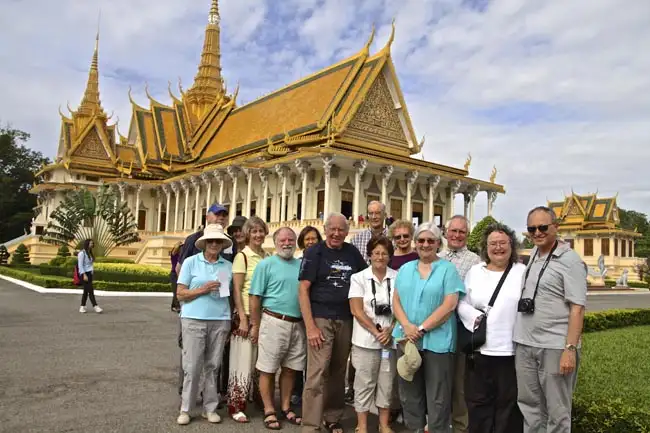
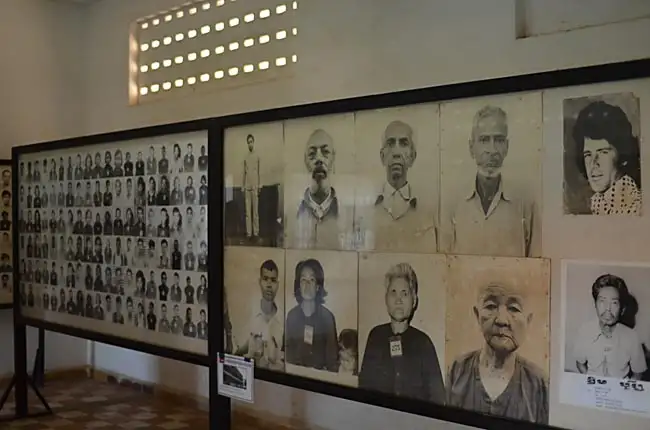

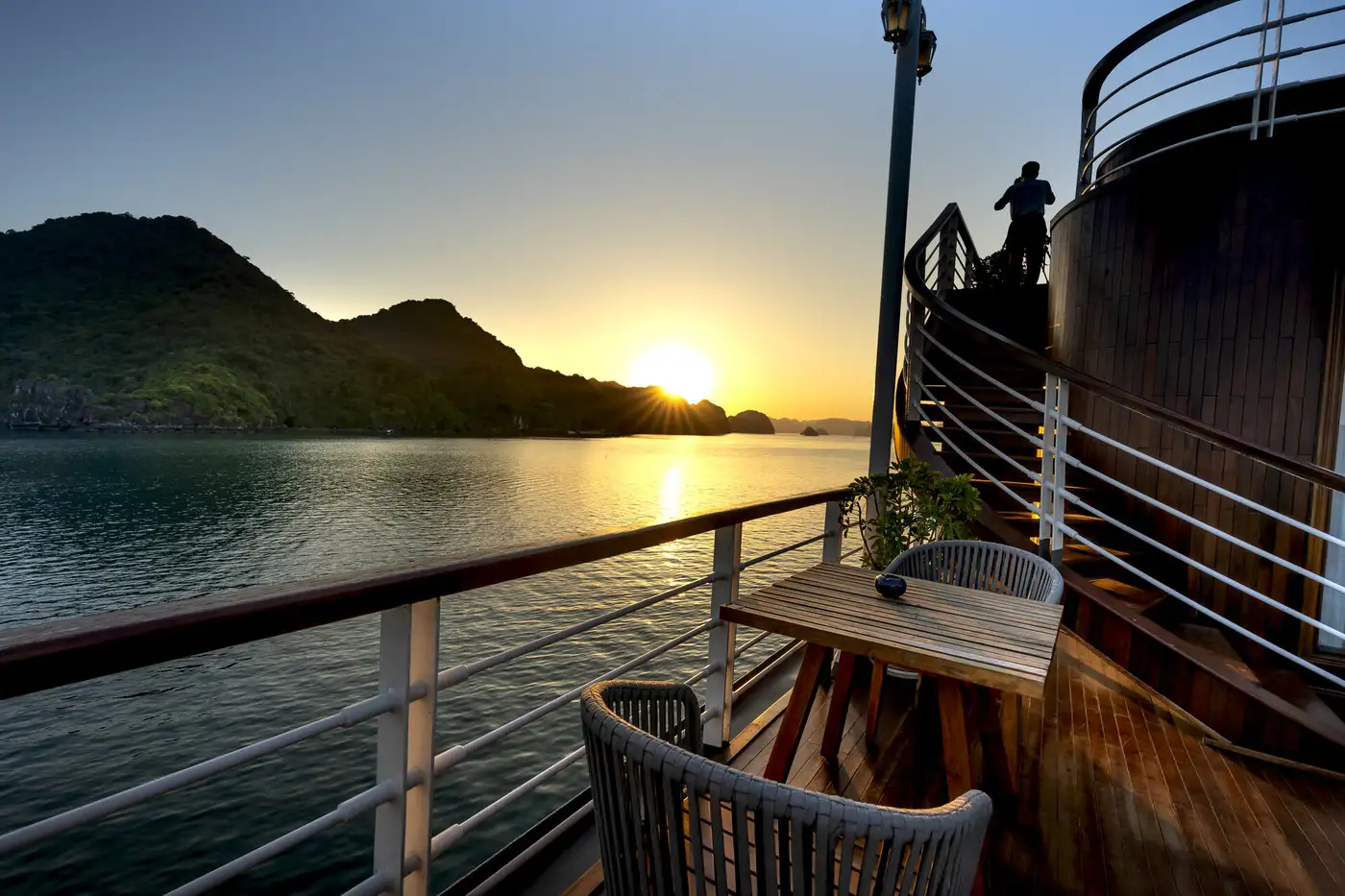

Excellent
Overall Rating
4.7
Extend Your Trip
This tour is part of a series that can be upgraded to make for a longer trip.
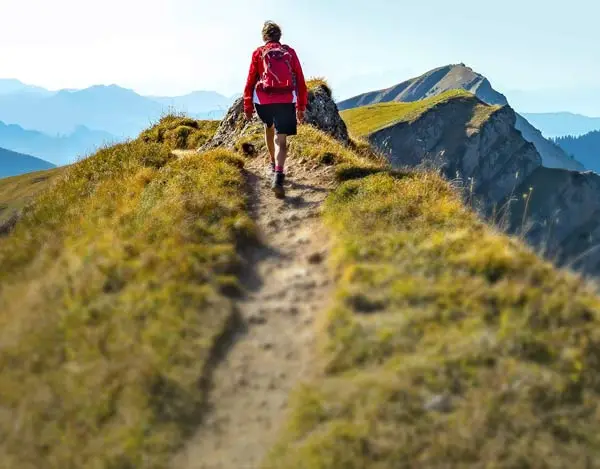
Fast and easy
Book This Tour
Book your unforgettable adventure today! For any questions or advice, don't hesitate to contact us.
Have questions?
1-800-665-3998
- Final payment: Due 90 days prior to departure.
- Deposit: A non-refundable $500 CAD Deposit is required at booking.
- Internal Flight Taxes: An extra $368 CAD applies for taxes and fees on tour flights. The internal airfares are included, but taxes are listed separately as they may change. Exceptions are noted in Red.
- Optional Single Supplement: $2520 CAD (number of singles limited).
(View options forsingle travellers) - Transfering Tour or Date: Transferring to another tour or tour date is only permissible outside of 120 days prior to departure and is subject to a $100 CAD change fee.
(Read our cancellation policy)
Choose your departure date:
Prices below are per person, twin-sharing costs in Canadian Dollars (CAD). Pricing does not include airfare to/from the tour and any applicable taxes.
Prices below are per person, twin-sharing costs in Canadian Dollars (CAD). Pricing does not include airfare to/from the tour and any applicable taxes.
Frequently Asked Questions
- What is the maximum number of participants on a trip?Most of our tours carry a maximum of 18 participants; some tours (ie hiking tours) top out at 16. In the event that we do not achieve our minimum complement by our 90-day deadline, we may offer group members the option of paying a "small-group surcharge" as an alternative to cancellation. If all group members agree, we will confirm the trip at existing numbers; this surcharge is refundable in the event that we ultimately achieve our regular minimum. If the small group surcharge is not accepted, we will offer a refund of your deposit or a different trip of your choice.
- Can I extend my tour either at the beginning or end? What about stopovers?Yes, you can extend your tour either at the beginning or the end and we can book accommodation in our tour hotel. Stopovers are often permitted, depending on air routing. Stopovers usually carry a "stopover" fee levied by the airline.
- How do I make a reservation? How and when do I pay?The easiest way to make a reservation is via our website; during office hours, you are also more than welcome to contact us by telephone.
A non-refundable deposit is payable at the time of booking; if a reservation is made within 90 days, full payment is required. Some trips require a larger deposit. If international airline bookings require a non-refundable payment in order to secure space or the lowest available fare, we will require an increase in deposit equal to the cost of the ticket(s).
Early enrolment is always encouraged as group size is limited and some trips require greater preparation time.
Once we have received your deposit, we will confirm your space and send you a confirmation package containing your trip itinerary, any visa/travel permit related documents, invoice, clothing and equipment recommendations, general information on your destination(s), and forms for you to complete, sign and return to us. Your air e-tickets (if applicable), final hotel list, final trip itinerary, and instructions on how to join your tour, will be sent approximately 2-3 weeks prior to departure. - What about cancellations, refunds, and transfers?Please review our cancellation policy page for details.
- I am a single who prefers my own room. What is a single supplement?All of our tours have a single supplement for those who want to be guaranteed their own room at each location.
This supplement is a reflection of the fact that most hotels around the world do not discount the regular twin-share rate for a room by 50% for only one person occupying a room. Most hotels will give a break on the price, but usually in the range of 25-30% of the twin-share rate. This difference, multiplied by each night, amounts to the single supplement.
The conventional amount can also vary from country to country and some destinations are more expensive than others for single occupancy. In order to be "single friendly," the supplements we apply are not a profit centre for us and we do our best to keep them as reasonable as possible.
On most tours we limit the number of singles available, not to be punitive, but rather because many hotels allow for only a limited number of singles; some smaller hotels at remote locations also have a limited number of single rooms available.
Please note that most single rooms around the world are smaller than twin-share rooms and will likely have only one bed. - Do you have a shared accommodation program?Yes! If you are single traveller and are willing to share, we will do our best to pair you with a same-gender roommate. Please note that should we fail to pair you, we will absorb the single supplement fee and you will default to a single room at no extra charge.
